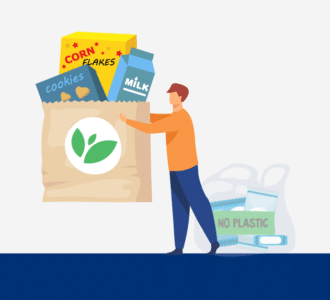The Food and Beverage (F&B) business is at the crossroads of some of the most pressing environmental issues we face. It is inextricably linked to our interactions with biodiversity and ecosystems. It is considered one of the primary causes of climate change by being the primary emitter of two of the top three greenhouse gasses and emitting a significant share of the third.
Simultaneously, F&B firms are very vulnerable to evolving customer expectations. Consumers, in particular, are becoming more aware of the environmental, social, and health-related implications of the food they consume. These developments may result in or contribute to new regulatory activities aimed at labeling and manufacturing procedures.
The aim of the article is to help you understand the evolving nature of business and regulations in the F&B sector with regard to ESG. The article is divided into the following sections:
- Key ESG issues in the F&B sector
- How is ESG changing business and driving regulations in the F&B sector?
- Complying with ESG regulations in the F&B sector: challenges and best practices
- Key takeaways
- How RegASK can help you with ESG compliance
Key ESG issues in the F&B sector
F&B typically has extensive and more complex supply chains because of the great variety of food we consume, place of origination, and producing techniques. These complications imply entanglement with key ESG issues and risks as well as many rules and regulations.
Carbon emission: It has been estimated that the current food systems worldwide are responsible for an approximately 26% of GreenHouse Gas Emissions (GHG)[1]. Crop production, Land use, livestock, fisheries and supply chain are the key areas contributing to the GHG emissions. Therefore, a single action would not solve the issue, the key is to create a system with changes that would lead to lower emissions in the F&B sector.
Improving land management, precision agriculture, and decentralized food manufacturing will reduce the amount of carbon from the food supply chain[2]. Similarly, improved energy and resource efficiency through automation and robotics, adoption of renewable energy, improved thermal management and sustainable packaging will help in the sustainable manufacturing of food and beverages[3].
Dietary changes such as switching to alternative proteins and adoption of resource efficiency techniques at food retail and distribution shops/centers are some of the practices to lower carbon emissions in the sector.
Food waste: The issue of food waste has been in the limelight for a few years. Reducing food waste is not only beneficial for the environment but also for the health of the people. Goal 12.3 of United Nations Sustainable Development Goals (SDGs) asks for lowering the global food waste at retail and distribution levels of the F&B supply chain[4].
Food waste can result from insufficient processing, mishandling of food, perishability of food, loss during environmental events, shipping and harvesting, or simply because food does not make it past the farm. It is also analyzed that food waste impacts human health through inhalation, consumption of contaminated food and water, and the spread of viruses through contaminated food chains[5]. Therefore it is important that steps like inventory optimization, food donation programs, and composting at household & commercial level techniques are used to minimize food waste.
Plastic packaging: It is believed that Asia accounts for a considerable portion of worldwide plastic waste leakage, with F&B packaging accounting for the majority of this. The F&B industry, as a significant user of single-use packaging, plays a vital role in combating plastic pollution. However, a study showcased that out of 68 companies only a quarter of the companies are addressing the issue through design innovation and recycling techniques of plastics, diving into circular packaging and engaging stakeholders in the topic of plastic[6].
Child & Forced labor: It has been estimated that Food manufacturing accounts for 15% of forced labor in the world, and 60% of these are children that are exposed to toxic chemicals and risky machinery on a regular basis.
To solve this issue, regions are coming up with rules and regulations such as the EU legislative framework that looks into Human Rights due diligence and the US bans products if there is any suspicion of child labor.
Need to learn more about ESG in F&B sector? Get in touch with RegASK experts
How is ESG changing business and driving regulations in the F&B sector?
1. New business initiatives and practices in F&B sector because of ESG movement
There is no doubt that ESG has been driving regulations, changing business strategies and forming new business initiatives in the F&B sector. However, each company in this sector might have specific concerns regarding ESG and the way they prioritize would differ from one company to another.
Companies might base decisions on the way their consumers prioritize their purchasing decisions as they are the greatest cause of pressure on food and drinks when it comes to ESG parameters.
There is another type of consumer whose decisions are being taken into consideration by F&B companies. Large restaurant and food shop chains frequently place constraints on their suppliers regarding a wide range of environmental and social concerns. For example, an American multinational supermarket has made it a prerequisite for seafood companies to have their products certified by a council or organization that sets standards for sustainable fishing.
 A multinational fast-food corporation has mentioned in their “supplier code of conduct” that “suppliers are responsible for managing, measuring and minimizing the environmental impact of their facilities” with regard to GHG emissions, waste management, and water use & disposal.
A multinational fast-food corporation has mentioned in their “supplier code of conduct” that “suppliers are responsible for managing, measuring and minimizing the environmental impact of their facilities” with regard to GHG emissions, waste management, and water use & disposal.
Technology is playing an important role in helping F&B companies manage supply chains. A company is using cold chain management technology to prevent food waste in supply networks. Thus, data will help companies in obtaining more knowledge about risks, boost transparency and assure that the companies are adhering to sustainable supply chain regulations.
Another source of pressure for ESG is coming from investors. Analysts, asset managers and independent investors are increasingly demanding that F&B companies comply with ESG regulations. Some investment funds focus on investing in environmental-friendly organizations.
A multinational food company issued a $1 billion bond which is considered the first sustainability-linked bond issued by a major meat firm. Similarly, a food processing conglomerate issued a sustainability bond to support the company’s ESG goals.
2. New and emerging ESG regulations and important initiatives in the F&B sector in key regions
United States |
||
|
ESG Regulation/Initiative |
Goal | Objective for Businesses |
|---|---|---|
| Supplemental Nutrition Assistance Program | Provides nutrition benefits to disadvantaged families for them to acquire healthy meals and work toward self-sufficiency. | Alleviate hunger and malnutrition by increasing resources for the purchase of food for a nutritious diet. |
| Food Loss and Waste 2030 | Reduce food waste by 50 by 2030. | Reduce the environmental and climate implications of food loss and waste while enhancing food security and saving money for households and businesses. |
| Coalition of Action on Sustainable Productivity Growth for Food Security and Resource Conservation | Accelerate the transition to more sustainable food systems by increasing agricultural productivity and maximizing agricultural sustainability across environmental, social, and economic dimensions. | A holistic approach to productivity growth that considers impacts and tradeoffs among multiple objectives. |
| Food is Never Waste Coalition | To cut food waste in half by 2030 and to reduce food losses by at least 25%. | To build and strengthen collaboration throughout food systems, between member states and organizations to ensure learning and sharing of best practice. |
| Agriculture Innovation Mission for Climate | This mission was established to enable combined solutions for agriculture and climate. | More rapid and transformative climate action in the agricultural sector by allowing greater public-private and cross-sectional partnerships. |
| Sustainable Food Policy Alliance | Enhance nutrition labeling and reduce the environmental effect of food production. | Advance climate policies that are impactful for the environment, while accounting for the specific business imperatives of supply chains, including farmers, ranchers, and other producers. |
| Packaging Producer Responsibility | Reduce the excessive use of plastic shopping bags (PSBs) through a direct economic disincentive imposed on consumers as a mandatory charge. | Reduce the excessive use of plastic shopping bags (PSBs) through a direct economic disincentive imposed on consumers as a mandatory charge. |
| Climate Action 100+ | Ensure that the world’s largest corporate GHG emitters take the necessary climate change measures. | Engage systemically important GHG emitters and other companies throughout the world that have enormous opportunities to drive the renewable energy transition and contribute to the Paris Agreement’s goals. |
| FDA Food Code | Protecting public health and ensuring that food is unspoiled and accurately presented to consumers. | Address the safety and protection of food offered at retail and in food service. |
United Kingdom |
||
|
ESG Regulation/Initiative |
Goal | Objective for Businesses |
| WRAP Courtauld Commitment 2025 | Reduce UK food waste by 20% per person by 2025 compared to 2015. | Courtauld Commitment 2025 brought together organizations across the food system to make food & drink production and consumption more sustainable. The agreement had ambitious targets spanning food waste, water and GHG emissions. |
| Food Waste Reduction Action Plan | Reduce food waste by 33% by 2025. | Reduce unnecessary demand and avoidable waste and optimize how we use organic resources. |
| Ambition 2025 | Reduce the GHG intensity of food and drink consumed in the UK by one-fifth by 2025, as well as per capita UK food waste. | Reducing CO2 emissions as well as quantitative and qualitative objectives related to water consumption, food waste reduction, use of more sustainable packaging, and transportation emissions reduction. |
| Sustainable Food Policy 2020 | Stimulate the sustainable development of organic products’ supply, going from the current 8% of organic farming crops to 25% in 2030. | The policy provides a framework for our commitment to ensure that food and beverages are produced, sourced, consumed, and disposed of in ways that conserve the environment, benefit society, and establish high standards for animal welfare. |
| National Food Strategy | Build a future food system that addresses environmental and health challenges, ensures the security of our food supply, and maximizes the benefits of technology. | Ensure an adequate and stable supply of safe and nutritious food, enhance the purchasing power of the people for increased food accessibility, and ensure adequate nutrition for all (especially women and children). |
| Rainforest Alliance | Protect forests, improve farmers’ and forest communities’ livelihoods, promote their human rights, and assist them in mitigating and adapting to climate catastrophe. | Making the world more sustainable by utilizing social and market forces to protect the environment and improve the lives of farmers and forest communities. |
| Good Food Policy | Protect the health and safety of consumers by reducing food-related risks. | Help consumers make informed choices about food by making sure they have the information they need and are not misled, support public health by promoting healthy food choices; maintaining and enhancing the nutritional qualities of food and responding to specific public health concerns, supporting a strong, sustainable food industry that offers a diverse, affordable food supply that also benefits the Australian and New Zealand economies. |
| Food Standards Act | To safeguard consumers against potential health risks and financial losses caused by items that breach food rules. | To keep customers from eating foods that are potentially detrimental to their health. |
European Union |
||
|
ESG Regulation/Initiative |
Goal | Objective for Businesses |
| EU Plastic Directives | Achieve a 90 percent collection target for plastic bottles by 2029 and 77 percent by 2025. | Ban plastic products which affordable alternatives are available, encourage plastic production with circular materials, and establish high uptake of recycled plastics. |
| Farm to Fork Strategy | Accelerate our transition to a sustainable food system. | Food loss and waste prevention, sustainable food processing and distribution, sustainable food production, sustainable food consumption. |
| Official Controls Regulation | Ensure the application of food and feed law, rules on animal health and welfare, plant health and plant protection products. | Animal health and welfare, plant health and plant protection products. |
| EU Food Hygiene Regulations | Protect public health and consumers’ interest in relation to food. | It establishes hygiene requirements that apply to all food businesses. Businesses identify and manage the risks associated with their operation through appropriate food safety management controls based on Hazard Analysis and Critical Control Point (HACCP) principles. |
| Single Use Plastics Directive (SUP) Directive | Plastic packaging is to become reusable or easily recyclable by 2030. | Reduce plastic litter, especially in the sea. |
| General Food Law | Protect human health and consumers’ interest in relation to food. | Food businesses must comply with food and feed safety law. |
Australia & New Zealand |
||
|
ESG Regulation/Initiative |
Goal | Objective for Businesses |
| The Food Standards Australia New Zealand Act 1991 | Ensure a high standard of public health protection. | Protect public health and safety, provide enough food information to allow customers to make informed decisions, and prevent fraud and deception, as well as misleading and deceptive behavior. |
| Food and Beverage Advertising Code (AANA) | Ensure that advertisers and marketers maintain a strong sense of social responsibility while advertising and marketing food and beverage goods in Australia in a legal, honest, and true manner that reflects health and safety regulations. | Reduce regulation on advertising essential foods and drinks and reduce the opportunity for children to view advertisements promoting occasional food or drinks. |
| The Food Act 2014 | Protect customers from consuming potentially hazardous foods. | Promote food safety by focusing on the processes of food production rather than the areas where food is produced. |
| Food Regulation 2015 | Improve upon the previous documentation by introducing numerous amendments in line with the concept of “fit for purpose” foods. | Achieve a better balance between maximizing food safety outcomes for consumers while minimizing regulatory costs of regulation on business. |
| Food Act 2003 (NSW) | Ensure that the food for sale is both safe and acceptable for human consumption. | To ensure food for sale is both safe and suitable for human consumption, to prevent misleading conduct in connection with the sale of food, to provide for the application in this State of the Food Standards Code. |
| Australian Pesticides and Veterinary Medicines Authority | Protect human and animal health and safety, the environment, and trade, while also supporting Australian agriculture, through science-based, effective, and efficient pesticide and veterinary medicine regulation. | Regulate agricultural and veterinary chemicals to manage the risks of pests and diseases for the Australian community and to protect Australia’s trade and the health and safety of people, animals and the environment. |
China |
||
|
ESG Regulation/Initiative |
Goal | Objective for Businesses |
| PRC Food Safety Law | Address growing domestic concerns about improper food additives, food product supervision, safety standards, and inadequate legal repercussions against violators. | Imposing stricter controls and supervision on food production and management. |
Singapore |
||
|
ESG Regulation/Initiative |
Goal | Objective for Businesses |
| Rice Stockpile Scheme (RSS) | Ensures adequate supply of rice in the market. | Mandatory for rice importers to hold a two-month stockpile in government warehouses. |
| Resource Sustainability Act (2024) | Build a sustainable, resource-efficient and climate-resilient nation. | Regulatory measures targeting the three priority waste streams of e-waste, food waste and packaging waste, including plastics. |
| Zero Waste Master Plan | To reduce the waste sent to Semakau Landfill each day by 30 percent by 2030. | Increase recycling, reduce waste, and guarantee that items are designed to be reused, mended, or recycled back into nature or the marketplace. |
| Deposit Refund Scheme | Aggregate post-consumer plastic waste, such as PET beverage bottles, and provide a steady supply of feedstock for recycling. | Encourage the take-back and recycling of packaging, such as plastic bottles and aluminum cans. |
| Singapore Packaging Agreement | Reduce packaging waste. | Imposing stricter controls and supervision on food production and management. |
Need to learn more about ESG in F&B sector? Get in touch with RegASK experts
Complying with ESG regulations in the F&B sector: challenges and best practices
There are global as well as region-specific authorities enforcing ESG regulations on the F&B industry. The FDA’s Food Safety Modernization Act (FSMA) asks companies to be fully transparent by applying the severe major rules to ensure the safety of food for both humans and animals[7]. GS1 is considered to be the most widely used barcoding system which helps in improving traceability and transparency across the international supply chain. Therefore, the ever-evolving policies and rules need to be strictly adhered to by the companies in this sector, which also leads to certain challenges as described below.
Challenges for F&B companies to adjust and comply
The F&B industry is arguably one of the most regulated industries globally and possesses great challenges for companies to comply with. Labeling is one of the challenges that companies face from the manufacturing stage to the supply chain level. The label is seen as a cross-departmental issue and the label itself needs to adhere to various regulatory standards that are always changing.
 Keeping track of the regulations is becoming increasingly difficult as enterprises expand their presence in different regions of the world. This has resulted in longer and more complex supply chains, with commodities passing through even more facilities and moving in many multiple directions before reaching customers. Each region or country might have its own set of stringent rules and regulations to be followed. Non-compliance with such regulations would lead to health and safety issues, penalties, supply chain disruption and jeopardized brand image.
Keeping track of the regulations is becoming increasingly difficult as enterprises expand their presence in different regions of the world. This has resulted in longer and more complex supply chains, with commodities passing through even more facilities and moving in many multiple directions before reaching customers. Each region or country might have its own set of stringent rules and regulations to be followed. Non-compliance with such regulations would lead to health and safety issues, penalties, supply chain disruption and jeopardized brand image.
Latest food and beverage fads such as veganism and organic necessitate additional rules to ensure that food producers are not misleading the customers. Furthermore, consumers are demanding that F&B companies be transparent about sourcing and supply chain activities. This becomes an obligation for the companies to fulfill their customers’ increasing demands and expectations.
Best practices
Despite the ever-evolving rules and constant pressure, companies in the F&B industry can focus their efforts on certain areas, as mentioned below.
Technology: Due to increasing traceability requirements from the manufacturing to the distribution stage, blockchain and sensor technologies can help them in being transparent and reducing human error.
Labeling: It is essential that companies label their food and beverages with utmost accuracy. This will prevent companies from running the risk of mis-selling the products and losing brand reputation.
Sustainable mobility: Companies can pledge to reduce the environmental impact of raw materials and finished product transportation. Shipping of products using intermodal transportation can be one such solution wherever applicable.
Quality Control: Even the greatest procedures may occasionally fail, which is why companies must incorporate checks and balances across all their production lines. Quality control is more than just inspecting products before they leave the facility; it also entails putting a number of precautions in place from the minute supplies arrive.
Sustainable packaging: Packaging plays a vital role in the F&B industry. Therefore, designers should not only design the packaging to meet the protection standards of the product but also keep in mind the sustainability of that packaging material. Switching to reusable, returnable, biodegradable and plant-based packaging are some of the smart ideas for F&B companies to adopt.
Need to learn more about ESG compliance? Get in touch with RegASK experts
Key takeaways
Several factors are pushing food firms to become more environmentally conscious. The various stakeholders of the F&B industry are demanding that companies shift from the traditional supply chain operations to a sustainable and resilient chain.
the F&B industry are demanding that companies shift from the traditional supply chain operations to a sustainable and resilient chain.
There has been a tremendous increase in the introduction of new rules and regulations in countries all around the world, forcing businesses to adopt smarter and more sustainable supply chains. Furthermore, consumers’ expectations and demands for choosing more sustainable products should not be overlooked. They have begun to hold companies accountable for their misconduct and fraud, which has been a crucial driver for the release of new regulations and legislation.
How RegASK can help you with ESG compliance
The F&B sector is subject to a plethora of regulations with regard to the production & manufacturing stage, packaging, supply chain and distribution. RegASK keeps you in compliance with F&B sector regulations.
These concerns are not going away, and F&B companies must consider long-term trends when making strategic investments. As a result, developing an ESG strategy to respond to and manage such risks is critical for businesses, and external consulting or platform tracking tools such as RegALERT and RegInsight can be beneficial and provide the company with the right expertise.
Our RegInsight Platform is an advanced version of machine learning technology used for driving real-time ESG Data. The platform detects trends and signals in the ESG subjects that have been identified in the scope and will immediately notify you about such regulatory changes by scanning an array of sources such as the latest news and insights, industry-specific websites, academic papers, and government & international websites.
RegASK also uses local regulatory affairs teams and a network of specialists as part of its advanced capabilities to deliver in-depth ESG intelligence as needed. To know more about the platform, contact us for a demo to ensure you choose the right path for developing an ESG strategy.
What you'll get with RegASK
- Early detection and mitigation of regulatory risks
- End-to-end regulatory support throughout your product lifecycle
- Strategic consulting to build the optimal business strategy for your commercial success
Book a demo
References:
[1] Our World in Data – Food production is responsible for one-quarter of the world’s greenhouse gas emissions
[2] Benjamin K. Sovacool, Morgan Bazilian, Steve Griffiths, Jinsoo Kim, Aoife Foley, David Rooney, Decarbonizing the food and beverages industry: A critical and systematic review of developments, sociotechnical systems and policy options, Renewable and Sustainable Energy Reviews, Volume 143, 2021.
[3] Benjamin K. Sovacool, Morgan Bazilian, Steve Griffiths, Jinsoo Kim, Aoife Foley, David Rooney, Decarbonizing the food and beverages industry: A critical and systematic review of developments, sociotechnical systems and policy options, Renewable and Sustainable Energy Reviews, Volume 143, 2021.
[4] Food and Agriculture Organization of the United Nations – Sustainable Development Goals
[5] Oliveira, Beatriz & Pinto de Moura, Ana & Cunha, Luís. (2016). Reducing Food Waste in the Food Service Sector as a Way to Promote Public Health and Environmental Sustainability. 10.1007/978-3-319-24660-4_8.
[6] Anna (Anya) Phelan, Katie Meissner, Jacquelyn Humphrey, Helen Ross, Plastic pollution and packaging: Corporate commitments and actions from the food and beverage sector, Journal of Cleaner Production, Volume 331, 2022.
[7] U.S. FDA – Food Safety Modernization Act (FSMA)

